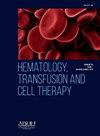如何治疗ph +急性淋巴细胞白血病
IF 1.6
Q3 HEMATOLOGY
引用次数: 0
摘要
急性淋巴细胞白血病(ALL)的治疗在Ph+ALL患者中得到了最大的改善。这些进步源于更精确的基因表征、量身定制治疗的使用、最小/可测量残留疾病(MRD)的精确监测,以及最后将免疫疗法纳入一线治疗。在酪氨酸激酶抑制剂(TKIs)出现之前,Ph+ALL是血液学恶性肿瘤,预后较差。tki的一线使用改变了该病的自然史。自2000年以来,意大利所有参加GIMEMA多中心方案的患者均接受单独TKI(加类固醇)诱导治疗,未进行全身化疗。随后的进展是添加双特异性单克隆抗体blinatumomab作为巩固,总是在没有全身化疗的情况下。GIMEMA LAL2116 (D-ALBA)试验对所有年龄患者的结果显示,在达沙替尼和blinatumumab诱导/巩固治疗后,分子反应率很高。在53个月时,记录的存活率为75%-80%,50%的患者仅接受TKI和blinatumumab治疗,没有化疗和移植。大多数MRD+患者接受同种异体移植。ikzf +患者预后较差,应在诊断时进行识别。如果可能的话,他们应该接受同种异体移植。在随后的3期GIMEMA ALL2820试验中,加入实验组并接受ponatinib和blinatumumab治疗的患者显示出更高的分子反应率,12个月时估计OS和DFS分别为94.9%和95.6%。有趣的是,在没有全身化疗的情况下,达沙替尼和波纳替尼加布林纳单抗的组合与显著的宿主免疫激活有关。MDACC组也报告了ponatinib联合blinatumumab的有效性,尽管该联合与更大的毒性相关。有关成人Ph+ALL治疗的综述见Chiaretti &;失落。GIMEMA ALL2820试验将最终显示有多少患者可以免于全身化疗和移植。在中期分析中,目前只有10%的患者在ponatinib + blinatumomab组接受了移植。我被要求涵盖“我如何治疗Ph+ALL”,更合适的应该是“我应该如何治疗Ph+ LL”根据GIMEMA试验收集的25年经验,最佳算法应该是:I)在诊断后一周内确定BCR/ABL基因病变的存在;ii)在此期间用类固醇治疗患者;iii)开始使用达沙替尼或波纳替尼加类固醇诱导,不进行全身化疗;iv)应进行中枢神经系统预防;v) MRD应在给定时间点进行分子监测;vi)诱导后,所有患者均应加强多周期blinatumumab治疗(在我们的方案中最多5个周期);7)不应停止TKI。通过这种方法,绝大多数患者——无论年龄大小——都会变成分子阴性。应在诊断材料上确定ikzf +患者。移植应提供给患者不利的遗传谱和/或MRD的证据。在随访期间应密切监测所有患者的MRD。为包括老年人在内的所有患者提供这种个性化的一线管理的可能性在很大程度上依赖于充分和标准化的实验室设施,这些实验室设施旨在进行广泛的诊断检查和准确监测MRD,以及最佳和及时地获得不同的药物。在现实生活中,这往往是不可能的。然后患者应接受TKI(加类固醇)诱导与轻度化疗。许多这样的病人接受同种异体移植。如果所有的难题都解决了,那么所有年龄段的Ph+ALL患者的未来看起来总是更有利的。随着布利纳单抗皮下制剂的出现,长期结果可能会更好。本文章由计算机程序翻译,如有差异,请以英文原文为准。
HOW I TREAT PH+ ACUTE LYMPHOBLASTIC LEUKEMIA
The greatest improvements in the management of Acute Lymphoblastic Leukemia (ALL) have been witnessed in Ph+ALL patients. The advancements have stemmed from an always more precise genetic characterization at presentation, the use of tailored treatment, the precise monitoring of minima/Measurable Residual Disease (MRD) and, finally, by the inclusion of immunotherapy in the frontline treatment. Prior to the advent of Tyrosine Kinase Inhibitors (TKIs), Ph+ALL was the hematologic malignancy with the worse outcome. The frontline use of TKIs has changed the natural history of the disease. Since year 2000 in Italy all patients enrolled in the GIMEMA multicenter protocols have been treated in induction with a TKI alone (plus steroids) and no systemic chemotherapy. The subsequent advancement has been brought by the addition of the bispecific monoclonal antibody blinatumomab as consolidation, always in the absence of systemic chemotherapy. The results of the GIMEMA LAL2116 (D-ALBA) trial for patients of all ages showed high rates of molecular response following an induction/consolidation treatment with dasatinib and blinatumomab. At 53-months, survival rates of 75%‒80% were recorded, with 50% of patients being managed only with a TKI and blinatumomab, without chemotherapy and transplant. Most MRD+ patients were allografted. IKZF-plus patients have a less favorable outcome and should be identified at diagnosis. When possible, they should undergo an allogeneic transplant. In the subsequent phase 3 GIMEMA ALL2820 trial, patients enrolled in the experimental arm and treated with ponatinib followed by blinatumomab showed even higher rates of molecular response, with estimated OS and DFS of 94.9% and 95.6% at 12-months. Of interest, the combination of dasatinib and ponatinib plus blinatumomab, in the absence of systemic chemotherapy, is associated with a marked host immune activation. The MDACC group also reported the effectiveness of ponatinib combined with blinatumomab, though the combination was associated with greater toxicity. For a review on the treatment of adult Ph+ALL see Chiaretti & Foà. The GIMEMA ALL2820 trial will conclusively show how many patients can be spared systemic chemotherapy and transplant. At the interim analysis, only 10% of patients enrolled in the ponatinib + blinatumomab arm have so far undergone a transplant. I have been asked to cover ‘How I Treat Ph+ALL’, which more appropriately should be ‘How Should I Treat Ph+ LL’ Based on the 25-year experience gathered through the GIMEMA trials, the optimal algorithm should be: i) Identify the presence of the BCR/ABL gene lesion within one week from diagnosis; ii) During this time treat patients with steroids; iii) Start induction with dasatinib or ponatinib plus steroids, with no systemic chemotherapy; iv) CNS prophylaxis should be carried out; v) MRD should be monitored molecularly at given timepoints; vi) After induction, all patients should be consolidated with multiple cycles of blinatumomab (up to 5 in our protocols); vii) TKI should not be stopped. Through this approach the large majority of patients – of all ages – will become molecularly negative. IKZF-plus patients should be identified on the diagnostic material. Transplant should be offered to patients with an unfavorable genetic profile and/or evidence of MRD. All patients should be closely monitored for MRD during the follow-up. The possibility of offering such a personalized frontline management to all patients – including the elderly – strongly relies on adequate and standardized laboratory facilities aimed at a broad diagnostic work-up and at an accurate monitoring of MRD, as well as an optimal and timely access to the different drugs. In the real life, this is often not possible. Patients should then undergo a TKI (plus steroid) induction associated with mild chemotherapy. Many such patients are offered an allogeneic transplant. The future of patients with Ph+ALL of all ages is looking always more favorable if all the pieces of the puzzle are in place. It is likely that with the advent of the subcutaneous formulation of blinatumomab the long-term outcome will look even better.
求助全文
通过发布文献求助,成功后即可免费获取论文全文。
去求助
来源期刊

Hematology, Transfusion and Cell Therapy
Multiple-
CiteScore
2.40
自引率
4.80%
发文量
1419
审稿时长
30 weeks
 求助内容:
求助内容: 应助结果提醒方式:
应助结果提醒方式:


